Black spots on a chicken’s comb are worrying because combs indicate a chicken’s health, and any unusual changes in them can be upsetting.
A single black dot on a chicken’s comb is usually normal, possibly from a minor injury, pecking, or scratching. However, multiple black spots on the comb might indicate various health problems in your chickens.
The most common reasons for black spots on the chicken comb are pecking, melanosis, frostbite, fowl pox, and other issues involved in these black spots. But the good news is that all these issues are preventable and treatable, so there’s no need to worry too much about them.
This article deeply discussed the causes of black spots on combs and their preventable and treatable measures.
Let’s start.
What is the Function of the Comb in Chickens?
The comb is a fleshy growth that grows from the skin layers and wattles, which are fleshy parts under their bill.
The comb on a chicken’s head indicates its health and helps it stay cool in hot weather. Chickens can’t sweat; their comb helps them cool down. Blood moves through the comb and wattles to release heat. This cools the chicken by moving heat from the blood to the air.
The comb also shows if a chicken is healthy and helps in mating. A healthy comb is firm, rubbery, brightly colored, and without marks.
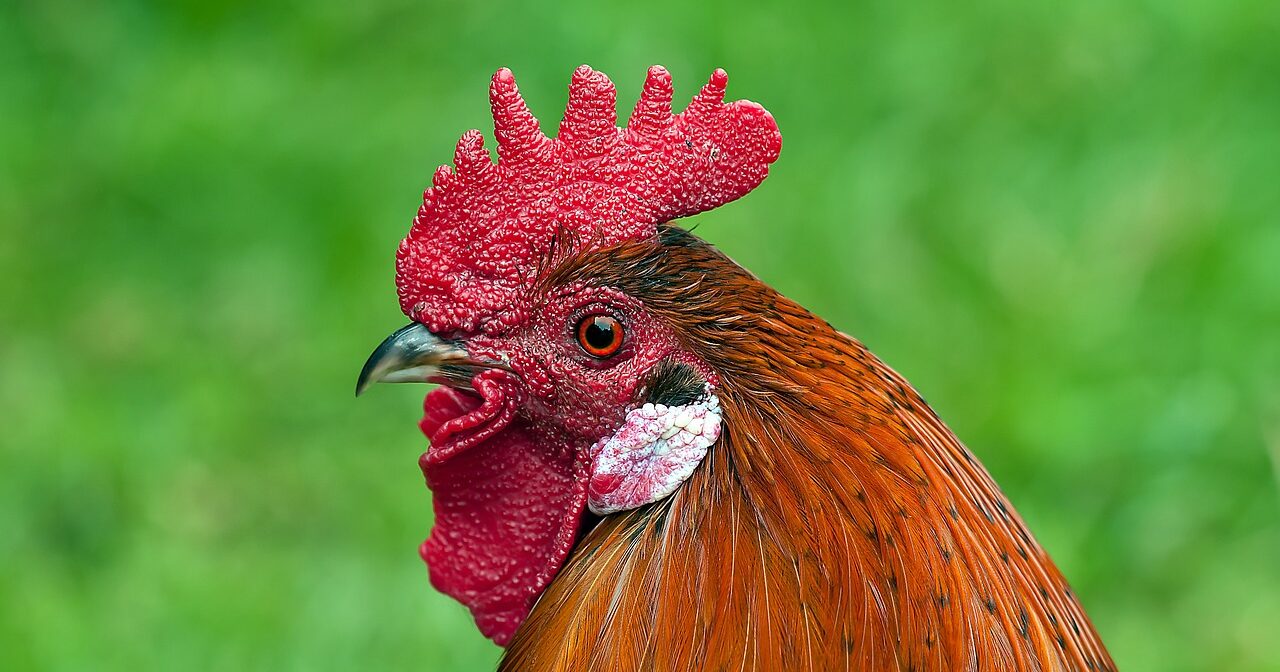
What do Black Spots on a Chicken’s Comb Mean?
Chickens are generally hardy birds, but changes in their physical appearance, such as the comb, can sometimes indicate their health. The comb, a fleshy crest on a chicken’s head, is an important health indicator. This can be alarming if it is infected or has abnormal black spots.
Black spots on a chicken’s comb mean several things. They might indicate health issues like injury, fowl pox, frostbite, mites or lice, nutritional deficiencies, environmental factors like sun exposure, pecking from other chickens, etc.
To prevent and manage black spots on a chicken’s comb, try maintaining good coop hygiene, providing ample space, monitoring your flock regularly, ensuring proper nutrition, and considering vaccinations for preventable diseases like fowl pox.
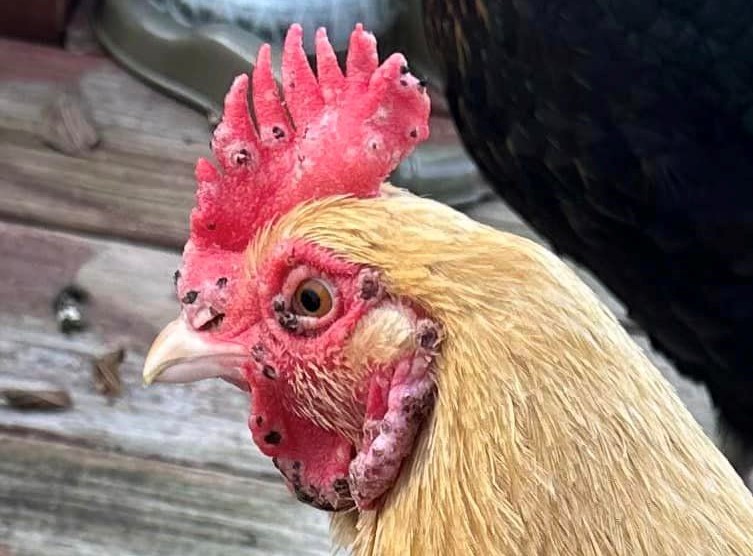
Why do my Chicken Combs have Black Spots?
It depends on your chicken. Black spots may indicate many different health problems. Single spots are usually normal, but multiple spots can indicate fowl pox, frostbite, melanosis, etc.
Sometimes, black spots on a chicken’s comb are normal pigment variations. Just as people have different colored skin, chickens differ in various colors, sometimes resulting in a black pigment that forms spots.
When the black spots appear suddenly with symptoms such as swelling, redness, discharge, or changes in behavior, they could show injury or infection. For example, bacterial or other diseases like fowl or avian pox can cause black spots on the comb.
Other than that, in cold weather, black spots might appear on chickens’ combs if they have been affect by frostbite. Frostbite is a condition in which tissues are damaged due to long periods of exposure to low temperatures, resulting in discolored areas. Sometimes, it can be caused by environmental factors such as sunshine or pecking from other chickens.
Close monitoring of the bird and immediate veterinary treatment will also be critical in such cases. Providing chickens with shade, clean water, and a quiet environment will help prevent these problems.
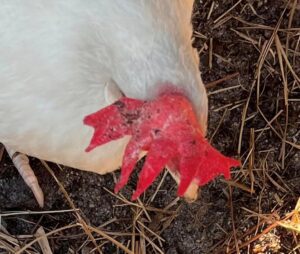
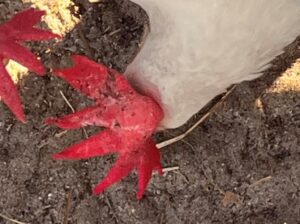
Chicken Comb Diseases and Reasons that Cause Black Spots on Comb
Injury or Damage:
Black spots on a chicken’s comb are often due to injuries. Here are two common reasons:
Injury: Chickens are curious and might hurt themselves by pecking at sharp things or getting stuck in fences. These injuries can cause scabs and black spots as the wounds heal.
Pecking or Scratching: Chickens establish a social order in their flock. Sometimes, they peck or scratch at each other’s combs. This can cause black spots and indicate aggression or stress within the flock.
- Prevention and Treatment
If peck marks turn into severe wounds, treat them like fowlpox. Clean the wounds and apply an appropriate ointment. Provide enough space in the coop or out of the coop. Temporarily separate the aggressive chicken to reduce tension and use Pinless Peepers; this can help prevent bullying behavior.
Hyper Pigmentation:
Sometimes, chickens get black spots on their combs but show no other signs of being sick. These spots can stay or disappear on their own. This condition is known as harmless hyper-pigmentation.
- Prevention and Treatment
No treatment is needed for this type of black spot on combs, and no prevention methods exist. Keep an eye on your chicken, but don’t worry—these spots are not harmful.
Ectoparasites:
External parasites like mites and lice live on chickens’ skin and feathers. These pests can cause health problems, including black spots on a chicken’s comb.
- Mosquito Bites
Mosquito bites can leave black spots on a chicken’s comb and transmit diseases like fowl pox and malaria.
Mosquitos thrive around pond edges with vegetation and swamps. Some mosquito species naturally dislike a chicken’s odor, but this doesn’t prevent bites. Last, don’t use chemical repellents for Mosquitoes, as they can harm your chickens.
- How to Reduce Mosquitos
Avoid stagnant water, like small backyard ponds.
Install mosquito traps near the chicken coop.
Use mosquito mesh netting.
Use insecticidal spray.
Plant mosquito-repelling herbs like citronella and lavender.
- Red Mites
Red mites are blood-sucking ectoparasites found worldwide. They multiply quickly and can turn into an infestation. Unlike fleas, mites hide in the chicken coop’s cracks during the day and bite chickens at night. Mite bites cause skin irritation and black spots on the comb. They also lead to stress, feather pecking, and aggressive behavior.
- Prevention and Treatment
Seal cracks using a blow torch, garlic, disinfectant, and paraffin. Try to clean the chicken coop and its surroundings thoroughly.
- Fleas
Flea Bites cause tiny black spots on a chicken’s comb and wattles. Sticktight fleas (Echidnophaga gallinacea) are common and attach to the chicken’s skin to suck blood. These fleas are about one-tenth of an inch long and remain attached for about 19 days, even when they lay eggs. The larvae nest in the chicken coop bedding and become adult fleas in about two weeks.
- Prevention and Treatment
Remove fleas with tweezers and apply antibiotic ointment on bite sites. Also, try to clean the chicken coop thoroughly and remove dirty bedding.
Other Flying Blood-Sucking Parasites:
Flying parasites can also leave black spots on a chicken’s comb. Examples include:
- Biting Midge: These parasites feed on the blood of chickens and birds and can transmit skin mites.
- Black Fly: They live in tropical climates and attack in swarms. They can transmit diseases to chickens.
General Prevention and Treatment for Ectoparasites:
To prevent these issues, try to maintain a clean environment, provide sand for dust baths, use diatomaceous earth in dust baths (with caution as it can irritate lungs), and spray the entire coop area with a disinfectant like Elector PSP or a bleach solution to prevent recurrence.
Treat each infected chicken with an appropriate powder or spray and cover their legs with something safe, like Vaseline, to prevent parasite eggs from hatching.
Dirtiness:
Chickens don’t take water baths like we do. Instead, they take dust baths to stay clean. Sometimes, dirt or mud can stick to their combs. This can make the comb look like it has black spots.
Before you think your chicken is sick, try cleaning the comb. Use warm water and a cloth. If the dirt is hard to remove, you can use a mild soap, like Dawn Dish Soap, to help clean it.
- Prevention and Treatment
Make sure the area where your chickens live has good drainage. This helps keep their environment dry and clean. Use dry straw or pine shavings in their bed or nest area. Add more as needed to keep it dry.
Sunburn:
Chickens with light-colored combs can get sunburned easily. Sunburn can make the comb darken or get black spots.
- Prevention and Treatment
Make sure your chickens always have access to shade. You can use trees, shrubs, shade cloth, a shelter, or a tarp. Always provide fresh water to keep them cool and hydrated.
If your chicken’s comb gets sunburn, you can treat it by applying soothing aloe vera to help it heal.
Vitamin Deficiency:
Sometimes, a chicken’s comb can darken or develop black spots because it is not getting enough vitamins in its diet.
- Prevention and Treatment
Ensure your chickens eat a balanced diet with plenty of vitamins and minerals, like fresh greens like carrots, and cucumbers, and grains like oats, corn, or wheat, or vitamin supplements to ensure they get enough nutrients.
Fungal Infections in Chickens:
Chickens can get fungal infections that cause black spots on their combs. These infections often happen because of poor sanitation or overcrowding in the coop.
- Common Fungal Infections
Aspergillosis: This infection can cause black spots on the comb, coughing, sneezing, and breathing problems.
Fowl Cholera: This disease can also cause black spots on the comb. Other symptoms include tiredness, loss of appetite, and diarrhea.
- Prevention and Treatment
Clean the chicken coop regularly to prevent fungal infections. Make sure the coop is well-ventilated. Give your chickens enough space to reduce the risk of infections.
Melanosis in Chickens:
Black spots on a chicken’s comb can sometimes be caused by a harmless condition called melanosis. This happens when melanin, a pigment, builds up in the comb’s skin cells.
- Causes of Melanosis
Sun Exposure: Spending a lot of time in the sun can cause melanin to build up.
Genetics: Some chickens are genetically more likely to develop melanosis.
Hormonal Changes: Changes in hormones can also lead to melanosis.
- Prevention and Treatment
Melanosis is usually not harmful and does not need treatment. It’s just a natural change in the comb’s appearance. However, checking with a vet is always a good idea if you are unsure or notice other symptoms.
Pullet Disease in Chickens:
Blue comb or pullet disease often affects chickens aged 15 to 25 weeks. This condition can cause a significant portion of a healthy flock to suddenly become ill, causing loss of appetite, diarrhea, dark comb, or even death.
Pullet disease is common in warmer conditions, or a lack of water or exposure to toxins or a virus might be involved in this disease.
- Prevention and Treatment
To prevent these issues, keep a close watch on the flock, maintain cleanliness in the coop, provide proper nutrition, and ensure a consistent water supply.
To treat this, ensure chickens have enough water supply or use antibiotics to treat the infection. Add Molasses to water for energy and Multivitamins to boost the chickens’ health.
Avian Ringworm in Chickens:
Favus, also known as avian ringworm, is a fungal skin infection that can affect chickens. This causes white spots, wrinkled crust, co-existence with black spots, and feather loss.
- Prevention and Treatment
Favus can spread to other animals and humans, so proper disinfection of coop surfaces, walls, roosts, and equipment is crucial. To prevent transmission, avoid contact with infected birds.
Apply topical fungal creams like Miconazole to the comb to treat the infection.
Frostbite in Chickens:
Chickens’ combs and wattles are sensitive to freezing temperatures, which can lead to frostbite. This issue is caused when fluids freeze inside the comb, and large combs are more prone to frostbite as they have less blood flow in cold weather; even cold-hardy chickens with smaller combs can suffer from frostbite.
When your chickens have frostbite, their comb turns pale grey and black due to the extreme loss of oxygen. They may exhibit distress, such as not wanting to move, eat, etc.
- Prevention and Treatment
To treat this issue first, slowly warm distressed chickens in a heated area to encourage blood flow, but do not use direct heat. If pecking occurs, isolate the chicken until it heals.
Treat open wounds with mild antiseptics like peroxide or polysporin, and applying petroleum jelly can aid in healing and prevent further frostbite. Watch for signs of infection in the affected area.
To prevent this, try to choose cold-hardy breeds like Barred Rock or Rhode Island Red. Ensure enough birds for warmth during roosting. Keep their bedding dry to prevent moisture-related issues and maintain proper ventilation in the coop to avoid humidity buildup.
Fowl Pox in Chickens:
Fowlpox is an infection that causes black nodules and scabs on a chicken’s skin. It mainly affects areas without feathers, like the comb, eyes, wattles, and legs.
This disease is caused by the avian pox virus, which is highly contagious and can be fatal to chickens. It can spread in a flock for many months.
Fowlpox comes in two types: dry and wet. Only the dry type causes black spots on the comb and wattles. The infection usually starts from mosquito bites. Fortunately, fowlpox is not contagious to humans and has nothing to do with chickenpox.
To recognize it, the black spots from fowlpox are different from peck marks. The nodules and scabs start as pimples, turn white or yellow, and become thick, dark scabs.
Sometimes, they can grow over the eyes, causing blindness. The scabs can last up to four weeks before falling off and being picked up by other chickens.
Fowlpox disease takes three to five weeks to run its course, and recovery is generally reasonable. However, complications can include slowed growth and decreased egg laying.
- Prevention and Treatment
Fowlpox is spread through contact with lesions, airborne flakes, and mosquito bites. If you notice pox marks on any unfeathered area of a chicken, quarantine the bird for 30 days. The scabs will heal in about four weeks.
Clean and disinfect the scabs to avoid secondary infections. When chickens are stressed, give them extra vitamin A to boost their immune response.
If a chicken gets infected, you should let the disease run its course and provide supportive care. Vaccination is the only way to prevent fowl pox. Consult your vet, who may recommend vaccinating chickens as early as 6 to 10 weeks old.
Try to cover the chicken’s legs with petroleum jelly to promote healing and ease discomfort.
Blackhead Disease in Chickens:
Blackhead disease, or histomoniasis, primarily affects turkeys, though chicken cases have occurred. Chickens can better withstand the more severe effects of blackhead disease, but they harbor the protozoan and can spread it to other fowl.
Transmission occurs through the larvae of the cecal worm, but it can be acquired when a fowl consumes earthworms infected with the eggs of cecal worms. Histomoniasis can also be transferred to the feces of other infected birds.
Common symptoms of blackhead disease are inappetence, weight loss, roughened feather coat, drowsiness, and yellow droppings.
Untreated, blackhead disease will always be fatal; dimetridazole added to drinking water or feed will stop infection. Isolate symptomatic birds. Incinerate all birds that die from the disease.
- Prevention and Treatment
To prevent infection, include the following in their water source weekly:
1 Tbsp of apple cider vinegar for each gallon of fresh water, three cloves of crushed garlic to repel internal parasites.
Consult a local vet for chemical-based treatments to eliminate parasites in the gastrointestinal tract and get into the habit of cleaning chicken coops frequently.
Rigorous cleanliness will help discourage the build-up of disease-causing organisms and help prevent blackhead disease. No antibiotics are licensed for treating it, but veterinarians can prescribe them.
Fowl Cholera in Chickens:
Fowl Cholera can spread through a flock, and signs include the comb and wattles turning a deep purple. They may have a deep purple discoloration of the comb and wattles, with mucus in the mouth. Green, watery diarrhea, loss of appetite, and a possible respiratory infection are also possible.
- Prevention and Treatment
Fowl cholera is prevented through cleaning routines, rodent prevention, and low-stress environments with proper ventilation. Vaccines are also available that are used to avoid the disease.
Antibiotics can treat Fowl Cholera, although they will not eradicate the disease. Therefore, culling infected birds and thoroughly sanitizing the coop area is suggested.
Avian Influenza in Chickens:
Avian influenza does not directly affect the color of the comb. An unwell chicken with bird flu will have a dull and discolored comb. The respiratory distress caused by avian flu may make the comb prone to turning cyanotic, appearing deep purple or blue, which could easily be mistaken for black.
- Prevention and Treatment
Reduce contact with wild birds and maintain cleanliness in the coop, feeders, and waterers. Quarantine any birds at the first sign of illness.
Suspected cases of Avian Influenza should be reported to the local veterinarian. It is highly unusual for a flock to recover completely; the usual goal is to prevent further virus spread through depopulation.
Black Spots on a Chicken’s Comb Pictures


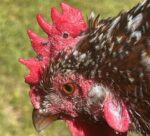
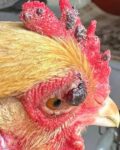
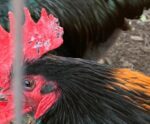

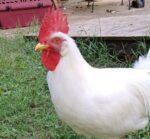

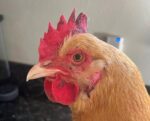

Ending
Black spots on chicken combs might cause significant health issues in your chickens if not treated well and at the right time. Some black spots may be caused by pecking or scratching; this is usually normal. However, multiple black patches can indicate health problems like fowl pox, frostbite, etc.
Always watch and observe your flock for any signs of illness, and seek help from a veterinarian to provide the best treatment for the chicken’s present issue.
Have you ever observed black spots on your chicken’s comb? If so, feel free to share your thoughts with us; we would love to hear from you.
FAQs
What causes white spots on the chicken comb?
White spots can be caused by fungus or a dry area. Fungal conditions can cause white spots on the comb, and Fowl Pox can sometimes look like these lesions, mainly on the head.
What causes black spots on chicken combs and wattles?
Several issues commonly cause black spots on chicken combs and wattles. One frequent cause is fowl pox, a viral disease that can lead to scabby lesions on the comb and wattles. Other causes include injuries from pecking, frostbite, or mites and lice.
Why do chickens’ combs turn black?
A chicken’s comb can turn black due to foul pox, Frostbite and Poor circulation due to illness or injury can also lead to a blackened comb.
Is black comb chicken edible?
Yes, chickens with a black comb can generally be eaten, provided they are otherwise healthy. The black color in the comb is usually due to localized issues like frostbite, fowl pox, or injury, which do not affect the overall quality of the meat.
Why is my chicken’s comb turning black in summer?
If a chicken’s comb turns black in summer, it might be due to fowl pox, which can occur in warm weather and is spread by mosquitoes. Injuries or pecking from other chickens can also cause black spots.
Why is my chicken’s comb turning grey?
A grey comb in chickens is often a sign of poor circulation, possibly due to a heart or respiratory condition. Sometimes, a grey comb can indicate anemia or a nutritional deficiency and stress.
Hello! I’m Ibrahim, the owner and writer of this blog. I run a chicken farm with 160 chickens, and I’ve gained a lot of knowledge about raising and caring for them. Now, I want to share my insights and experiences with you to help you in chicken keeping.


6 thoughts on “Black Spots on a Chicken’s Comb | Causes and Treatment”